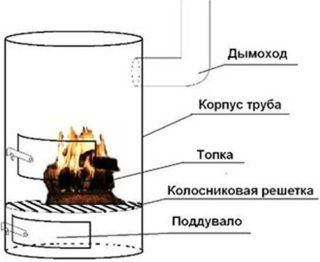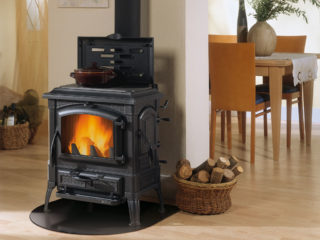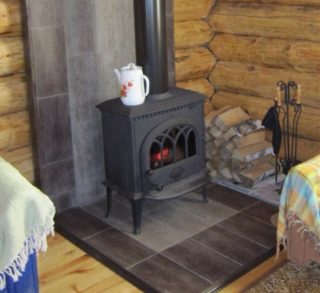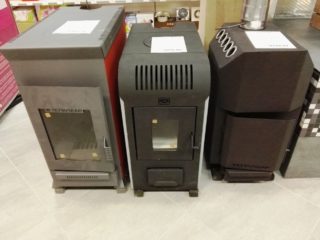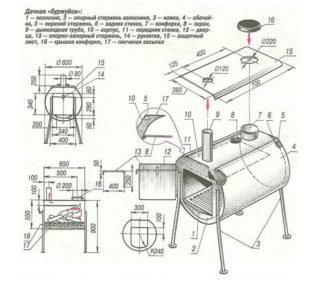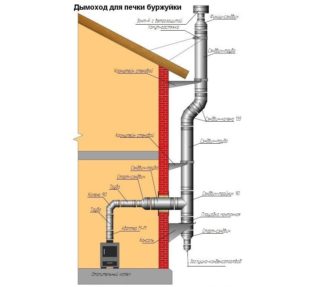The convenient stove stove is known since the 18th century and still continues to be a more profitable alternative to expensive fireplaces and large stoves. The device gained wide popularity due to its trouble-free operation and simple design, it could be easily made independently, but the main disadvantage of such furnaces was high fuel consumption. Modern potbelly stoves are most often installed in bathhouses, in dachas or in apartments as an element of decor, while using them for their intended purpose is quite economical and does not cause problems.
Principle of operation
The stove a potbelly stove is a compact device suitable for heating small rooms. With its help, you can quickly heat the room and maintain the optimum temperature in it for a long period. For such a furnace, additional equipment is not required, it is easily transferred from one place to another, if we are not talking about a stove from a bricklaying brickwork for a summer residence, and is installed without much effort.
It is not so difficult to assemble a potbelly stove yourself, for example, from bricks, barrels or old cylinders. In addition to the main structural elements, it can be supplemented with a heat exchanger, with which it will work much more efficiently. This part provides long burning and necessary heat transfer when using any fuel. For the device to function correctly, it is worthwhile to prepare its drawing in advance, where all the details will be taken into account. A standard potbelly stove consists of the following elements:
- long burning chamber;
- an ashpit;
- pipe outlet for a standard chimney;
- legs and frame;
- door with a latch.
In equipment of this type, as in other furnaces, a chimney with a door must be present to maintain combustion at the desired level and comply with safety standards.
Varieties of bourgeois
The army oven is available in several versions and is divided into categories depending on the purpose, materials and type. By designation, such devices are divided into heating options intended for space heating, and stoves with hobs. Cast iron or metal is used as the material for their manufacture. Cast iron devices are characterized by a low level of thermal conductivity, but at the same time they are able to retain heat indoors for as long as possible.
Due to the heavy weight of cast iron, it is problematic to transport such furnaces, so they are installed in one place for a long time. Variants of metal with special screens quickly heat the room, but give off heat faster due to its accelerated output. It is best to purchase metal stoves supplemented with external sheets of metal, which will allow the device to remain hot for a long time even after turning it off. If desired, the stove can be additionally finished with bricks, tiles and other materials.
Classic
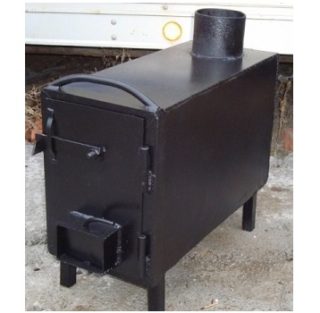
Depending on the duration of combustion, the stoves are also divided into two types. The classic version is characterized by low efficiency, rapid combustion of fuel, combined with long heat retention. The special design of the device is made so that the heat intensity depends on the flow of incoming air. You can install a stove of such a plan in the house or in the country, taking into account the requirements for its installation.
Long burning
Iron wood stoves belonging to this type are distinguished by a higher cost.They have a single-chamber design, require a rare fuel supply, since in long-burning devices it is consumed more slowly. It is more difficult to kindle such stoves, air is dosed inside, fuel is not added until the previous portion is burned. They have their own advantages, including good efficiency, a high level of efficiency and low fuel consumption.
What are stoves suitable for?
Thanks to the primitive and simple design, a stove-fireplace or a standard-type stove is suitable for any room that needs full heating. It can be installed in the country, in the bathhouse, in a private or country house. Manufacturers offer a fairly extensive range of such stoves, among which you can find stylish options that can fit into the interior. The fireplace-potbelly stove intended for the country house will be very handy in the cold season.
Inexpensive options with a chimney or a hand will become a real godsend for owners of summer cottages and private buildings, where you can not carry gas. Modern stoves are much better than the Soviet RF in terms of heat retention, large devices can also be used to heat rooms with an impressive area. Quite expensive options of various sizes with a great design and a high level of fire safety, including bath or wood stoves, are also available on the market.
When choosing a device, it is important to determine in advance for what purpose it will be used, since modern stoves are not only suitable for heating. They can be used for cooking or as a decorative element.
Pros and cons of bourgeois
Modern bourgeois have much more advantages in comparison with devices popular during the USSR. They are compact in size, do not cause difficulties during operation, are combined with various types of fuel, and at the same time are quite economical in comparison with gas heating appliances. Most structures do not weigh so much, so they are easy to transport if necessary. They are also easy to install, this process will be accessible even to a novice familiar with safety rules.
A practical Armavir or water heater of such a plan quickly heats up and at the same time consumes fuel as economically and efficiently as possible, continuously heating the room for 6-10 hours. Cast iron and metal models for the home or garage are durable and do not require special care, and for most stoves, the installation of a capital type chimney or a special pipe is not required.
This type of furnace has its drawbacks, for example, the lack of autonomy and the presence of a risk of fire, which can be minimized by monitoring the device. During operation, it is better not to touch the furnace body in order to avoid burns, since it always gets very hot.
How to make yourself
To make a potbelly stove yourself is easiest from two metal barrels according to the standard scheme. For this purpose, two barrels will be needed, one of which should be smaller. The upper part is cut from each, metal handles and locking type parts are attached to the remaining part. Before starting work, it is better to rinse the barrels thoroughly to get rid of the unpleasant smell that could remain there. The assembly of such a furnace according to the rules consists of several stages that are performed step by step:
- A rectangle of 25x10 cm is cut out at the bottom of a large barrel, this compartment will become a compartment for a drawer.
- Two guides with a size of 2.5x2.5 cm need to be attached to the bottom.
- A pallet is cut out of a metal sheet along a contour of a thickness of not more than 1-2 cm, which will become the basis for the camera and can isolate it from the ash pan.
- In the central part of the pallet and the bottom of a small barrel, a 6 cm hole is cut out, after which the pallet is welded at a distance of at least 15 cm from the bottom of the container.
- At the final stage, a hole is made in the casing of the large barrel, which is needed for the flue pipe and a convenient shutter with a small handle is built into the pipe.
- A small barrel is placed inside a large one so that each hole in them matches.
To add fuel, a cone with a length of at least 1.5 meters is made, which is made of metal or wood. The bottom of such a cone should freely pass through the hole in the pallet.
Material Options
Mostly potbelly stoves are made from metal barrels or gas cylinders, using additional materials and equipment for this purpose. In order to make a full-fledged device, it is advisable to first prepare a drawing of the future brick or cast-iron potbelly stove stove and stock up with all the necessary materials. In the drawing, the main and auxiliary parts, for example, a heat exchanger, are indicated in advance. Ovens from a barrel and a cylinder are assembled according to a similar scheme in compliance with all stages.
A more acceptable option is to build a brick oven, a device of this type has more advantages, it cools slowly and retains heat longer. Also, brick stoves look quite neat in any room. For a collapsible or conventional furnace of this type, there are two construction options, it can be built using bricks independently according to the standard scheme or bricked with finished metal stove. The choice of option depends on the situation and the amount of free time.
What kind of chimney is needed
Without a chimney, it will be impossible to use a potbelly stove, so it is worth taking care of this part in advance. To make a pipeline, you can purchase finished pipes or make them yourself from sheet metal. The second option will cost less. In the assembly process, a chimney is collected from the pipes and the corner element, which is then welded to the finished potbelly stove.
The material used for the chimney is brick, pipes of steel or other metal, ceramics, vermiculite or asbestos cement. Choose the appropriate option based on the budget and complexity of installation.
Sometimes chimney pipes are made of special heat-resistant glass, but special skill is required to work with this material. Glass chimneys are also not practical.
The best choice for beginners will be finished stainless steel pipes, their main advantages: low weight, reasonable price and the absence of difficulties at all stages of assembly.
